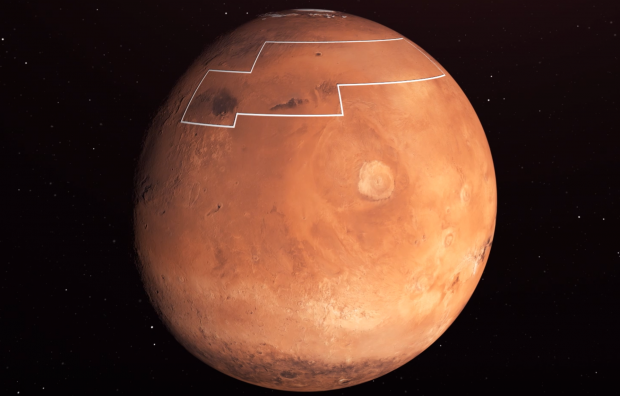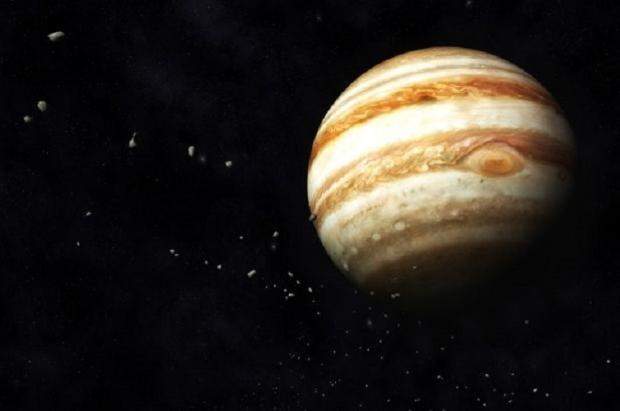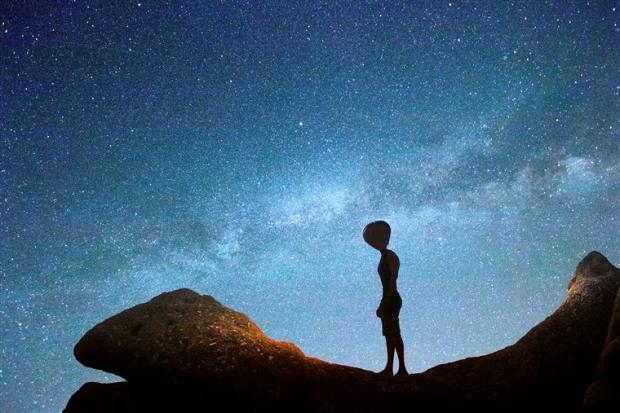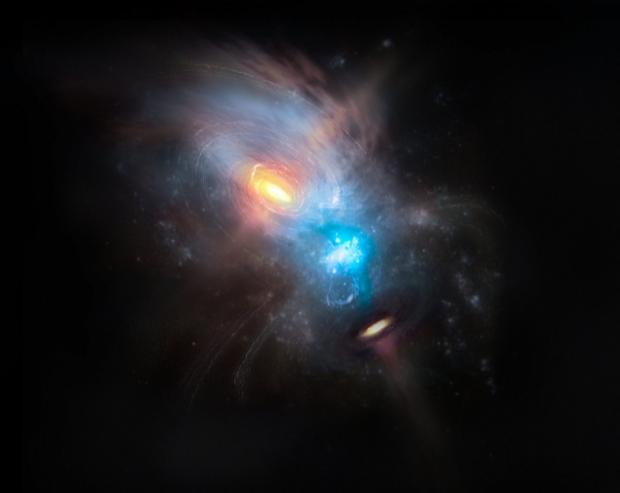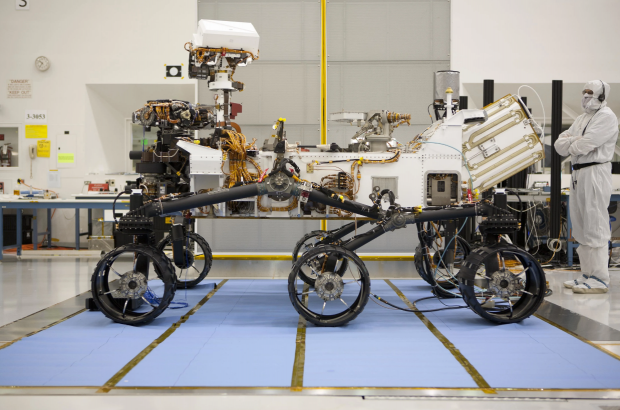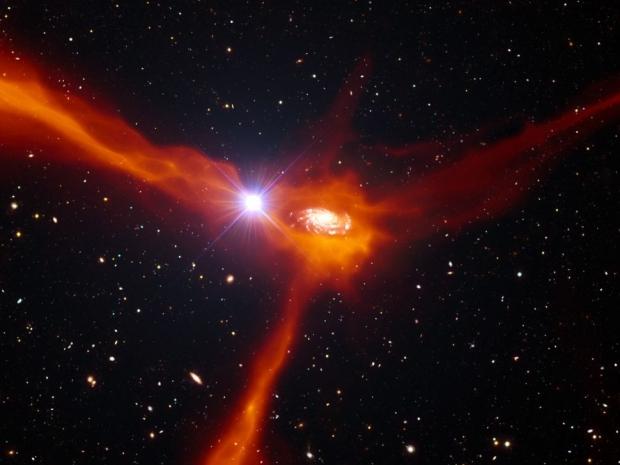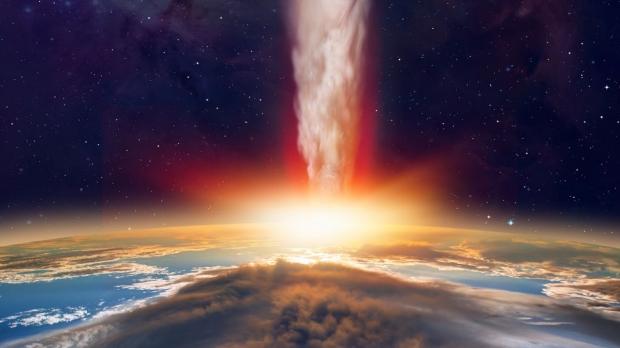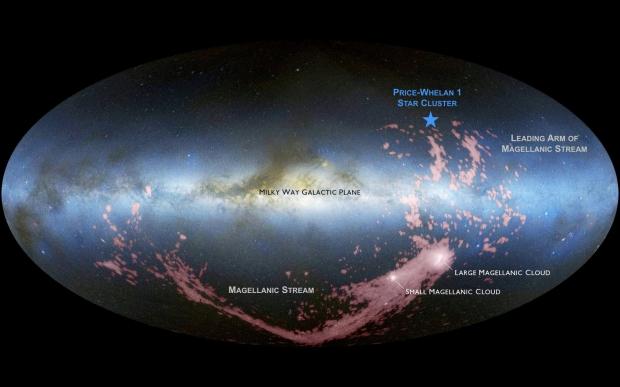Science, Space, Health & Robotics News - Page 371
There's buried treasure on Mars, and NASA will land humans to find it
NASA is constantly working on getting humans to our Red Planet neighbor, but there is one big question that needs to be answered first -- where are they going to land and why?
In a new paper published in Geophysical Research Letters, scientists managed to create a map through the analysis of satellite data (MRO & Mars Odyssey orbiter) that shows where martian water is located. This martian water is more accurately called 'water ice', and according to NASA's website, "Water ice will be a key consideration for any potential landing site". This is because if humans can harvest resources on Mars, they will have a steady means of fuel replacement and drinkable water.
Due to the air pressure on Mars being so thin, liquid water can't last on its surface for very long as it evaporates. This is why NASA has identified some key spots across the planet that have "buried treasure". This 'treasure' is, in fact, water ice and its located just under the martian surface. According to Sylvain Piqueux of NASA's Jet Propulsion Laboratory in Pasadena, California, "You wouldn't need a backhoe to dig up this ice. You could use a shovel. We're continuing to collect data on buried ice on Mars, zeroing in on the best places for astronauts to land."
Continue reading: There's buried treasure on Mars, and NASA will land humans to find it (full post)
Billionaire starts 'female partner' contest, winner goes to the Moon
Sometimes a little companionship is all you need, especially if you are blasting off to space to be the first prospective rider aboard SpaceX's deep-space rocket.
Japanese billionaire, Yusaku Maezawa is after just that as he has launched a campaign to find a suitable "female partner" to accompany him in his flight around the Moon. Maezawa has started a new website promoting the "girlfriend" campaign, and according to the website "He wants to visit such a special place together with a special someone." There are conditions to applying, they aren't very strict so don't worry.
The website states that applicants have to be; "Single women aged 20 or over, bright personality and always positive, interested in going into space and able to participate in the preparation for it, want to enjoy life to the fullest, be someone who wishes for world peace." Back in September last year, Maezawa put down a large deposit to be the first private customer to ride on SpaceX's Starship once it was completed and ready for flight. Starship won't land on the Moon with passengers. Instead, it will take passengers around the Moon, giving them a perfect look at it.
Continue reading: Billionaire starts 'female partner' contest, winner goes to the Moon (full post)
Jupiter is meant to shield Earth from asteroids, not sling them at us
Jupiter is meant to protect the Earth from space rocks, not slingshot them towards our direction. Or at least that's what astronomers originally thought, the contrary might shape up to be true.
Astronomers originally thought Jupiter's massive size and gravitational pull were saving Earth from experiencing many dangerous space rocks. While that theory might still be relatively true, it might be as full proof as once thought. Kevin Grazier, a former NASA scientist and now planetary physicist, used computer models to simulate the solar system and how space rocks interact with its planets.
What he found in these simulations was, "Our simulations show that Jupiter is just as likely to send comets at Earth as deflect them away, and we've seen that in the real solar system." In the early days of Earth forming, this principle of asteroids crashing into Earth was a good thing, as essential ingredients for life to occur (ice, minerals etc) were redistributed on Earth's surface. Today though, it could end in millions of lives being lost. Remember what happened to the dinosaurs?
Continue reading: Jupiter is meant to shield Earth from asteroids, not sling them at us (full post)
Major scientific 'oxygen' breakthrough could help NASA find aliens
A new breakthrough in being able to measure oxygen levels on distant planets has just happened, meaning NASA now has more assistance in locating alien life.
The breakthrough was published in Nature Astronomy and describes a new technique that can be used by NASA's telescopes to measure oxygen levels on distant planets. Oxygen being one of the vital building blocks of life, is what NASA is searching for on distant planets, so any help towards making that location process easier is most-welcomed. The new technique can be used by the James Webb Space Telescope.
Thomas Fauchez, from NASA's Goddard Space Flight Center and lead author of the study, said "Before our work, oxygen at similar levels as on Earth was thought to be undetectable with Webb. This oxygen signal is known since the early 1980s from Earth's atmospheric studies but has never been studied for exoplanet research." While spotting oxygen on distant planets isn't a 100% guarantee that there is extraterrestrial life located there, it does give NASA and scientists some conclusive evidence that a particular planet has a building block of life.
Continue reading: Major scientific 'oxygen' breakthrough could help NASA find aliens (full post)
Astronomers caught two supermassive black holes merging on camera
Two galaxies that both have supermassive black holes are merging together and astronomers caught it on camera.
It takes billions of years for galaxies to merge, the process is long but it is a gorgeous one to observe. An team of astronomers used the extremely powerful telescope called Atacama Large Millimetre Array (ALMA) to observe the collision between two galaxies that both have supermassive black holes. Above is the images that were taken with ALMA.
The images don't show the black holes as its extremely difficult to take images of them. But what we can see is all of the light and gas that has failed to escape their ridiculous gravitational pull. That gas that's surrounding the black hole is feeding the black holes, causing them to grow larger and larger as gravity moves both the galaxies closer together to form a new galaxy called NGC 6240.
Continue reading: Astronomers caught two supermassive black holes merging on camera (full post)
NASA's Mars 2020 rover will search for life on Mars' surface
NASA recently completed the Mars 2020 rover separation test and its first test drive, earning the rover its official martian driver's license.
NASA is planning on sending the newly designed rover to Mars this July, and things are looking up when it comes to running on schedule. Why in July? Well, that's quite simple. Due to the Earth and Mars' elliptical orbits once every 26 months, both planets are in the closest proximity of each other, precisely 35.8 million miles. Choosing to launch in July isn't just a placeholder date, its the most practical time to get the rover there and establish it on Mars' surface to begin testing.
The Mars 2020 rovers' main mission is to seek out signs of ancient microbial life and even prepare the surface of Mars for future terraforming missions. To seek out potential signs of ancient life, NASA scientists have equipped many bells and whistles on the rover, in fact, it will be carrying 10 different measuring instruments, have 23 cameras and microphones are placed all over the rover to allow for scientists to listen to any potential faults. The rover will also have an X-ray spectrometer, radar, solar-powered drone, and more nifty gadgets.
Continue reading: NASA's Mars 2020 rover will search for life on Mars' surface (full post)
Physics crisis: scientists can't agree on the universes expansion rate
The discrepancy between calculations of the speed of which the universe is expanding has been increased. Scientists can now not fully agree upon what that constant value is.
First a bit of history. The problem we are talking about here is called the Hubble constant, which was first calculated by American astronomer Edwin Hubble. Hubble discovered that every galaxy in the universe is moving away from Earth at a rate proportional to the distance between Earth and that galaxy.
At first glance, one would assume that Earth is at the center of this universe, but instead, astronomers were smart and said that there is a distinct relationship between how far objects are apart from each other, and how fast they are moving away from each other. The problem behind this way of thinking is that scientists and astronomers alike haven't been able to agree on a constant value of what that speed-distance connection is.
Continue reading: Physics crisis: scientists can't agree on the universes expansion rate (full post)
Photographed Black Hole is emitting jets at 99% the speed of light
Back in April last year, humans achieved something had never done before - taking an image of a supermassive black hole. Now, that black hole has been caught emitting jets that are traveling close to the speed of light.
The black hole that we took a picture of is called Messier 87 (M87), and according to NASA's Chandra X-Ray Observatory, that same black hole has been caught emitting jets of material from its accretion disk. The accretion disk is where gas, dust, and other materials swirl around the black hole, and some of the materials are sucked into the black hole, while some are shot back out into space.
The X-ray data indicated that some of the particles that were moving in the jets were traveling faster than the speed of light. While that might sound impossible, it's only possible because of the phenomenon known as superluminal motion. Brad Snios, a postdoctoral researcher at the Harvard-Smithsonian Center for Astrophysics, said "The jet travels almost as quickly towards us as the light it generates, giving the illusion that the jet's motion is much more rapid than the speed of light".
Continue reading: Photographed Black Hole is emitting jets at 99% the speed of light (full post)
800,000 year old meteor crater that covered 10% of Earth in rock found
Over the course of Earth's life many meteors have slammed into its surface, scientists know about the impacts but have struggled to find the craters, until now.
One meteor, in particular, crash-landed into Earth around 790,000 years ago, and the explosion that it created blanketed 10% of the Earth in rock debris. The debris was launched all the way from Indochina to eastern Antarctica and from the Indian Ocean to the western Pacific. Scientists were aware of the impact the meteor created but were unable to find the crater until just recently.
Through the analysis of geochemical and local gravity, scientists were able to pinpoint the impact location to southern Laos on the Bolaven Plateau. The crater was found under a massive field of cooled volcanic lava that spanned a ridiculous 2,000 square miles. According to the recent study, scientists estimated that the crater impact measured in at about 300 feet thick, 8 miles wide and 11 miles long. In the entirety of this article, you will find a geological map of what the scientists have comprised out of evidence.
Continue reading: 800,000 year old meteor crater that covered 10% of Earth in rock found (full post)
Extragalactic stars found from Milky Way's galactic collision course
Astronomers have managed to spot something quite unexpected at the outer rims of our Milky Way galaxy -- new stars forming.
How is this happening? According to Price-Whelan and his colleagues who presented their findings on January 8 at the American Astronomical Society meeting in Honolulu, spectral analysis has shown that these young stars are not of this galaxy and are actually from another. This means that these stars haven't formed from material located in the Milky Way, but have instead come from two close dwarf galaxies called the Magellanic Clouds.
Both of these galaxies are currently on a slow collision course with the Milky Way, and it seems that a stream of gas extending from the galaxies is making its way into the Milky Way and forming new stars. Primary discoverer Adrian Price-Whelan, a research fellow at the Flatiron Institute's Center for Computational Astrophysics in New York City, said "This is a puny cluster of stars-less than a few thousand in total-but it has big implications beyond its local area of the Milky Way". Price-Whelan also named the star cluster - Price-Whelan 1.
Continue reading: Extragalactic stars found from Milky Way's galactic collision course (full post)


